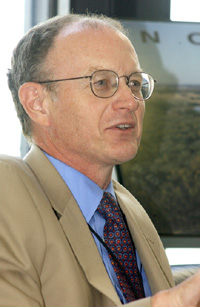 |
|
Looking Ahead: Fermilab Prospects in 2004
As we approach the New Year it is a good time to predict the future. What will be happening at Fermilab in 2004? Below are my predictions. Some are pretty sure bets; some are more speculative, and at least one is a long shot. I will let you decide which prediction falls into which category. The CDF and DZero collaborations will make public many important new results throughout the year, intensifying the competition to be the Result of the Week in Fermilab Today. In August, Run II results will make news at the International Conference on High Energy Physics in Beijing. The Tevatron collider will deliver as many collisions to the experiments as it has in all its previous history, so that the total data sample available for physics will be twice what it is today. The recycler will perform as planned and the beam line for electron cooling of antiprotons will be installed. It will be a big year for neutrinos at Fermilab. In December we will be starting up the beam line that will send neutrinos to Minnesota. The MINOS collaboration will be producing physics results using atmospheric neutrinos in their far detector, as they tune up to receive Fermilab neutrinos. The MiniBooNE collaboration will have enough events on tape to answer the question of whether there is a fourth light neutrino. Nobody will know the answer yet, however. The Physics Advisory Committee will make recommendations that shape the future of neutrino physics at Fermilab. The BTeV project will be blessed with exactly what they have been asking for--a whole slew of DOE and Fermilab reviews. By the end of the year they will be near the official launch of the construction project. The worldwide search to detect dark matter directly will take a big step forward with the first physics results from operation of the Cryogenic Dark Matter Search experiment in the Soudan mine. Similarly, the discussion of the highest energy cosmic rays will revolve around early results with the partially-built Auger observatory. The Fermilab long-range planning committee will produce its report early in the year. It will be used to guide the direction of R&D toward future projects at Fermilab.
The Sloan Digital Sky Survey will continue to produce impressive results and striking pictures. The International Technology Recommendation Panel will report its recommendation on the chosen technology for the linear collider, and that recommendation will be accepted. Governments will talk more seriously about how to organize an international linear collider project.
New results from the Tevatron experiments and from the B-factories will show that we do not yet understand everything about the particles made from heavy quarks. Theorists from Fermilab and around the world will engage in a lively debate about their competing explanations of the data. There will be even fewer workplace accidents at Fermilab than the record-best year we are just finishing, due to the efforts of everyone who works at the laboratory. Technicians, surveyors, physicists, engineers, and other specialists will work together in the tunnels to renew and upgrade the accelerator complex during the annual shutdown. This work will make it possible to deliver more luminosity, increase proton intensity, start up NuMI, and operate the accelerators more reliably. People from all over the laboratory will rise to the challenge of providing the administrative and technical support needed to do the great science discussed above. One of the experiments mentioned above will produce a surprising new physics result that will become Fermilab's Result of the Year. The Fermilab budget for fiscal year 2005 will be 10 percent greater than this year.
On the Web:
Fermilab |
| last modified 12/31/2003 email Fermilab |
FRLsDFx9eyfrPXgV

